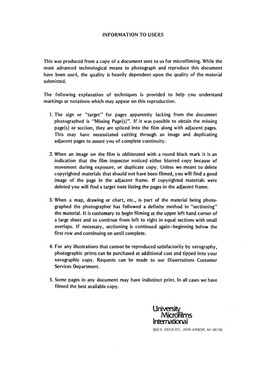| dc.contributor.author | Olson, Robert Lydon, | en_US |
| dc.date.accessioned | 2013-08-16T12:28:23Z | |
| dc.date.available | 2013-08-16T12:28:23Z | |
| dc.date.issued | 1981 | en_US |
| dc.identifier.uri | https://hdl.handle.net/11244/4889 | |
| dc.description.abstract | For Marguerite Duras, life is an annihilating passion that is most appropriately expressed by an antithetical and irrational apprehension of reality. There is a progressive feminacy in the characters, be they men or women. The early novels, harmonious and cerebrally conceived, show a masculine, ordered interpretation of reality. With the middle and more recent works, wordy theorizing is replaced by a muted, poetic introversion of experience. The emergence of the psychotic heroes and antiheroes reveals Duras' revolt against the Freudian reality principle which masks the antithetical, destructive nature of human experience. | en_US |
| dc.description.abstract | Table of Contents: Chapter I - The Itinerary of Duras' Protagonists; Chapter II - The Heroes' Coming of Age; Chapter III - The Drunken Boat: The Animus Odyssey; Chapter IV - Interior Songs: The Anima Syndrome; Chapter V - Rapt, Rapture, Ravishment: The Fugue of the Disintegrating Rational Hero; Chapter VI - The Psychotic Episodes of the Irrational Heroes: An Epistemology of Folly; Chapter VII - Antiheroes of Destruction and of Myth: Their Transition from Novel to Film. | en_US |
| dc.description.abstract | The evolving conception of characterization in Marguerite Duras' novels offers to the student of the mid-twentieth century French novel the rare, if not unique, opportunity to observe the diverse manifestations of the novelistic protagonist, from the traditional heroes through the antiheroes of the New Novel, within the thematic context of a single creative imagination. The evolution of Duras' heroes and heroines serves as a microcosm of the experimentation in serious fiction that has occurred during the literary generations in France since the Second World War. Although in recent years the author's energies have been directed to the theater and, in particular, to the cinema, her twenty novels, spanning a period of thirty years (1943-1973), show a mastery of both the traditional and the avant-garde approach to characterization. | en_US |
| dc.description.abstract | From the publication of her first novel in 1943, the expanding scope of the literary itinerary of Marguerite Duras takes the reader from novels whose protagonists are "coming of age" to the most recent works which signal the end of an age. Ironically, as the verisimilitude of the characters and their world progressively contracts, their philosophical and mythic import is dramatically amplified. | en_US |
| dc.description.abstract | The itinerary of Duras' characters described in this study is therefore one of a regression beyond the limits of a rational epistemology. This evolution does nothing less than put into question the foundations of modern civilization. It is an itinerary of revolution and destruction on three levels: aesthetic, psychological, and social. The heroes of this literary odyssey permit the reader to view the progressive metamorphosis of heroes into antiheroes, of novels into antinovels, and, ultimately, of the antinovels into films. | en_US |
| dc.format.extent | 272 leaves ; | en_US |
| dc.subject | Literature, Romance. | en_US |
| dc.title | The expanding significance of the shrinking hero in the novels of Marguerite Duras. | en_US |
| dc.type | Thesis | en_US |
| dc.thesis.degree | Ph.D. | en_US |
| dc.thesis.degreeDiscipline | Department of Modern Languages, Literatures, and Linguistics | en_US |
| dc.note | Source: Dissertation Abstracts International, Volume: 42-07, Section: A, page: 3178. | en_US |
| ou.identifier | (UMI)AAI8129405 | en_US |
| ou.group | College of Arts and Sciences::Department of Modern Languages, Literatures, and Linguistics | |
